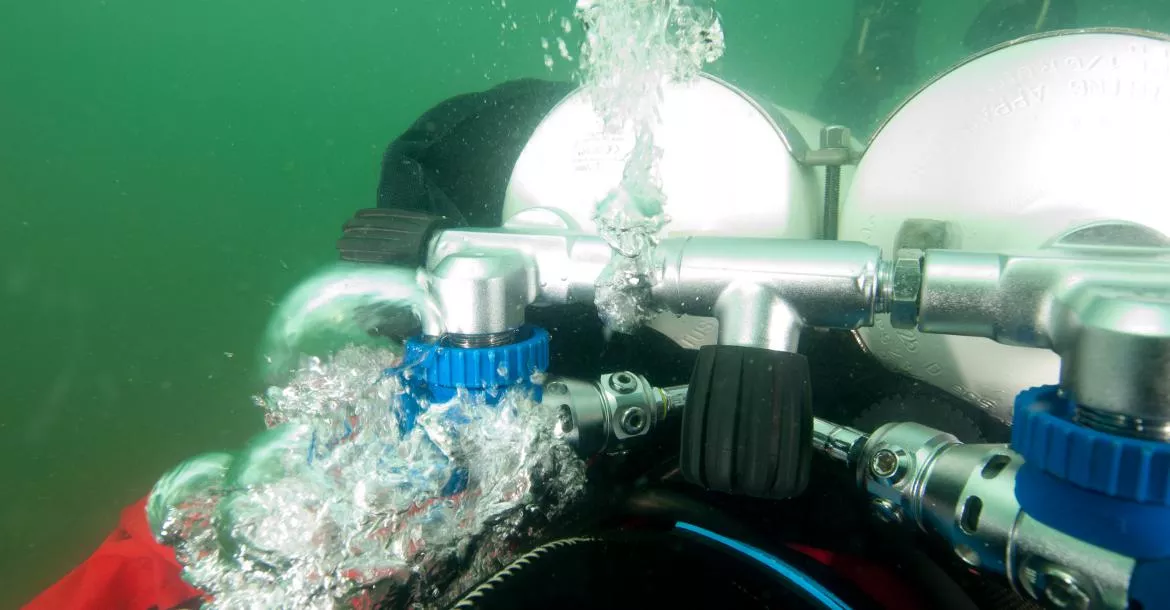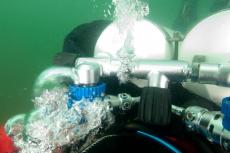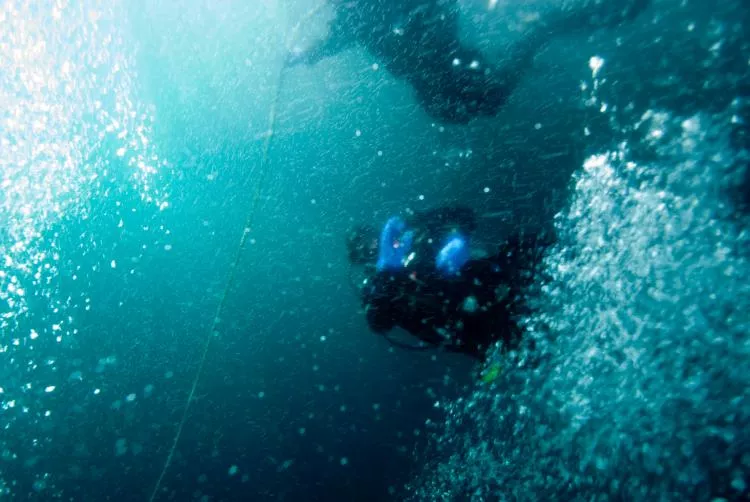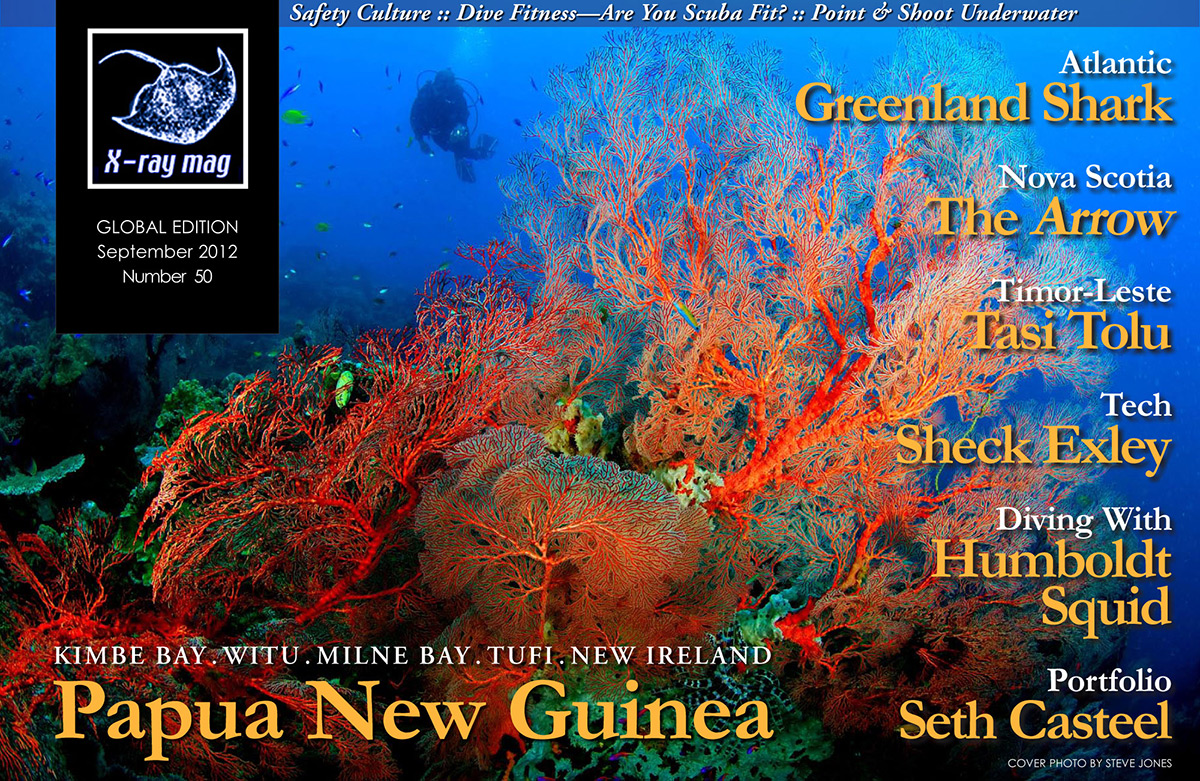“Thank [beep] for that! How lucky were we? We better not do that again.
Don’t tell anyone though, we don’t want to look like amateurs...”
Contributed by
The problem with not letting people know what happened is two-fold. Firstly, others can’t learn from your mistakes; and secondly, the ‘authorities’ don’t obtain the evidence to show that there is a problem with whatever it was that went wrong.
Many of the more experienced divers lay criticism on the dive education agencies for not providing adequate training, and yet there is extremely limited hard evidence to show that there are problems with such things as lack of buoyancy control or gas management. There is, however, plenty of anecdotal evidence, when you speak to divers on boats or in the pub.
Everyone makes mistakes, even world-leading divers—those at the top of their game, the sort of people we aspire to be. So, if they have made mistakes, there is a very high probability that you or I have made similar mistakes, or errors, on a dive. Unfortunately, those who didn’t recognise the threat, or risk, until it is was too late are no longer here with us today taking part in a fantastic sport exploring our underwater world.
The following is a series of actual incidents that have ended with fatalities.
- Entering the water with O2 turned off on a rebreather; the diver died shortly afterwards.
-
Switching to 50% when at 36m depth and carrying on the dive down to below 50m because the diver hadn’t followed correct protocols for gas switching; the diver died after approximately an hour on the 50% bottle at depth.
-
Incorrectly labelling an emergency bailout cylinder so that it was placed at an incorrect depth leading to it being breathed at 3.2 ppO2; the diver had a seizure and died very shortly afterwards.
-
Task fixated in lifting an artefact, using backgas to inflate the liftbag as the original inflation cylinder had already been sent to the surface, and consequently running out of gas at depth, and then the diver did not use established protocols to use the dive buddy’s gas; the diver died following a rapid ascent to the surface.
Getting away with it
These are all simple mistakes and maybe the sort of thing that some of the readership might have done and ‘gotten away with’. If you did make a mistake like this, did you tell anyone or report it to the wider diving community through BSAC or another reporting system such DISMS?
Without knowing what prevalent problems are and why they occurred, it is very hard for training agencies to know how much emphasis to place on certain activities during training courses. It is also very hard for divers to accurately quantify the risks they are taking when they ‘break the rules’.
In addition, before you personally mitigate a risk (in risk management terms—tolerate, treat, transfer or terminate) you need to be able to identify it. However, from the commercial standpoint of the diving industry—that diving as an activity that needs to be promoted as a ‘safe’ sport in order to continue feeding new divers into the system—‘promoting’ these risks is not necessarily good for business.
Providing an environment where divers, instructors and those involved in management of diving and diver training operations can report honest mistakes and near misses is essential. This environment is one where it is accepted that we all make mistakes due to the limit of our experience, knowledge, training or the situations in which we are placed—an environment where the reporting of those mistakes, or near misses, is to be encouraged.
But at the same time, it is an environment where negligent or malicious behaviour is not condoned and allowed to continue. This environment is known as a ‘Just Culture’ environment and is part of the wider ‘Safety Culture’ that this sport should embrace if we are to reduce the number of injuries and fatalities occurring.
However, calling it a Safety Culture might have connotations of a ‘nanny state’, and as a consequence, the more experienced or independent divers may want to rebel against it. The discussion on a well-known internet forum following the Rebreather Forum 3.0 consensus position that checklists should be produced and used for closed circuit rebreathers to improve safety is a classic example of this.
The Just Culture aspect
A Safety Culture is not one entity, but rather is made up of a series of component ‘Culture’ parts. These include an Informed Culture, a Reporting Culture, a Learning Culture, a Just Culture, and finally, a Flexible Culture (see green box at right)
A Just Culture cannot exist on its own, but rather is interlinked with the other cultures. You cannot understand who has done what, when or why without an established reporting culture, and you won’t get those subjects to report if they think there isn’t an issue and don’t understand the risks that may occur if the situation conspires against one (informed culture).
The puzzle is not complete unless you have a Just Culture, as divers will not report an incident if they think they are going to be unjustly or inappropriately blamed for the incident or accident. Finally, a learning culture is required to know more about the risks that are out there—simplistically, gluing the pieces together.
Responsibility... personal responsibility
Looking at the tabloids, one could argue that society is now taking less personal responsibility for actions, appearing to look for someone to blame, rather than undertaking some sort of ‘personal risk assessment’— the so-called ‘Elf and Safety’ culture we now live in. Despite this, divers can be given training via a range of agencies and courses about how to undertake diving safely.
During that training, they should be taught to exercise caution as well as what the implications are of going beyond their trained limits, as they expand their experience and knowledge. Unfortunately, when a diver breaks these rules, and something goes wrong, there is a tendency to look for someone to blame for the incident, rather than understand why that diver made the mistakes they made.
This ‘blame culture’ means that companies are less willing to be involved in such a ‘hobby sport’—especially supporting closed-circuit rebreather (CCR)
This ‘blame culture’ means that companies are less willing to be involved in such a ‘hobby sport’—especially supporting closed-circuit rebreather (CCR) equipment—and safety will be reduced as a consequence.
Diving is considered a relatively safe sport considering the environment in which we undertake it, with a fatality rate of approximately 1:200,000 dives per year.
However, those figures are not precise, with between 10 and 24 fatalities and more than 350 divers treated for decompression illness (DCI) each year.
In addition, from recently presented material at Rebreather Forum 3.0, CCR diving is considered to have ten times greater fatality risk than open circuit (OC) diving. Despite these numbers being relatively low, divers need to be aware of the risks they are taking; we are undertaking a sport that cannot be conducted without technical and mechanical life support equipment, and if this fails, there is a real risk of death. Partners and family members need to know the risks we are taking, and most importantly, that human error is the most prevalent root cause of diving fatalities.
Fortunately, mistakes don’t always lead to a fatality and much can be learned from non-fatal incidents; the prevalence of these compared to fatalities is likely to be in the order of 1:600, as per previous engineering studies. Consequently, there needs to be a means by which the outcome and solution can be discussed in an open and non-critical manner, thereby allowing others to learn from non-fatal episodes.
If mistakes aren’t corrected, they can become the norm—because-I-got-away -with-it—turning into bad habits. These bad habits need to be checked in a non-confrontational manner to bring the diver back to baseline.
Diving is a fun activity, but these bad habits could be as simple as dragging or dangling equipment, poor buoyancy control or not analysing gas to ensure that the maximum operating depth (MOD) is known. If these habits are not corrected by the training organisation (or the diving community at large), there is implicit acceptance that what the divers are doing is correct and acceptable.
Simple things like asking divers if they have analysed their gas—it maybe that a diver is relying on it in an emergency—or what their gas consumption, or planned pressure, is for leaving the bottom can help a lot.
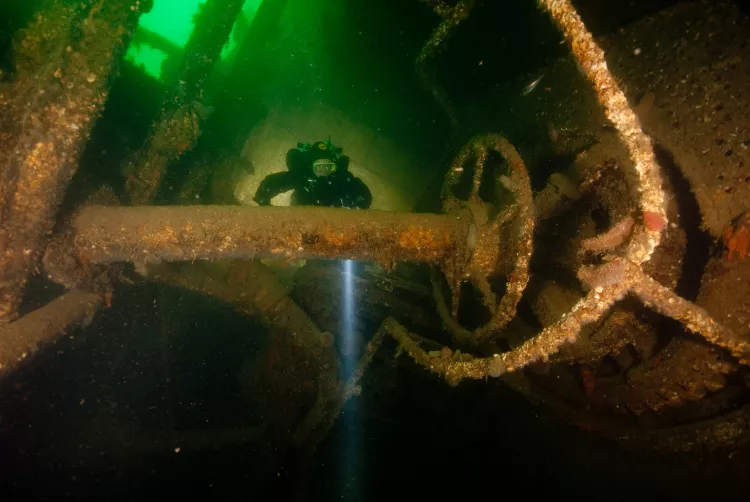
What YOU can do to help the wider diving community
In the United Kingdom, there are a couple of reporting systems available to the diving population: the BSAC Incident Report, which is open to all divers from all agencies wherein an annual report summary is produced, and the Diving Incident and Safety Management System (DISMS at www.divingincidents.org), which is an online open and confidential reporting system independent of all agencies and manufacturers.
DISMS allows a search to be conducted against the live public dataset, producing results then and there. So, if data is updated after the annual report (covering January 1 to December 31) is published, the revised data can still be accessed.
By reporting your incidents and accidents, the sport will be better informed of the risks that are occurring, and training agencies can focus their efforts more accurately.
I have been quoted many times as being able to provide numbers on why incidents occur. However, until people start submitting reports in meaningful numbers, the data is will not be there. In addition, the reports need to be relatively detailed to allow the ‘why’ to be determined’ rather than just the ‘what’. The following is an example of why the backstory is required.
An experienced advanced trimix diver and instructor who had been using a KISS rebreather for a while had made a habit of turning his rebreather unit off when on the bench while taking off his kit—because he had left the unit on several times in the past only to return and find an empty O2 bottle.
This practice gradually backtracked, evolving from turning the valves off while de-kitting on the bench, to turning off the O2 while walking to the bench, to turning it off already when he was getting out of the water, as his gear was being lifted onto the back of the boat after his dive.
On the day in question, he was waiting in que behind another diver to get out of the water at the pick-up point. He presumed that the diver in front of him would be out of the water in a couple of minutes. At this point, he turned off his O2.
Unfortunately, the boat had to circle around again in order to pick up the diver in front of him.
He was, however, still breathing off the loop. Once he finally got picked up, the pO2 was a little low!! He felt rather unwell standing on the lift, looked down at the handset and noticed that the partial pressure of O2 had fallen all the way down to 0.07! He spat out the loop and started to feel better. A few seconds more and he would have had major problems [ed.—because he was so close to fainting from hypoxia.
The reason why he didn’t get a suffocating sensation due to lack of oxygen was because this sensation is caused by CO2, which was still being removed by his rebreather canister. So essentially, he was depleting his oxygen without noticing it.]
If this had been reported as just, “A diver switched off his O2 in the water”, people would have (rightly) thought he was a fool and should have known better. However, if the backstory had been reported, it would have become clear what led the diver to complete the actions he did, even if they were wrong.
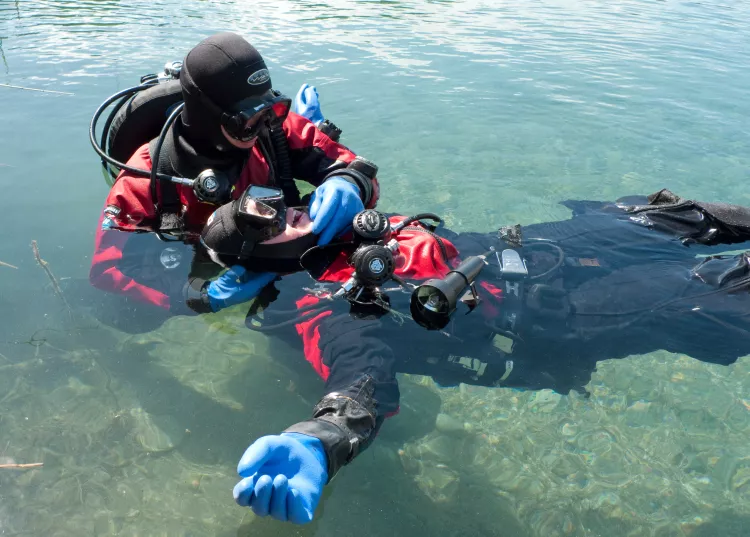
It’s your attitude!
Simply speaking, in a safety culture, we choose to do the safe things all the time, not just when someone is watching or assessing us. A Just Culture is only a part of the wider ‘Culture’. While articles like this one can highlight what a Just Culture is to the diving community, it really takes the organisations of the dive world to actively promote it at the top level, so that it cascades down to the instructor trainer staff, the instructors, and ultimately, the divers themselves.
Diving is a recreational activity with limited legislation (and rightly so).
Consequently, it is much better to encourage and lead by example—i.e. more carrots, less sticks.
For example, a leading U.K. rebreather instructor Paul Haynes has been promoting the use of mouth-piece retaining straps for rebreather users, so they can maintain a gas source even if they happen to go unconscious. This has led to an effective campaign on one CCR forum where at least 20 CCR divers have bought them, and the subject was added as a consensus position at Rebreather Forum 3.0 this May— a small, simple and cheap change, which has the potential to reduce fatalities.
A Just Culture does not have to be mutually exclusive to a recreational activity, nor does it have to cost a substantial amount of money to implement. However, what it does require is an attitudinal change within the industry and educational organizations as well as those partaking in the sport.
Hiding something away because you made a mistake doesn’t help anyone.
However, divers’ concerns about being treated fairly—without judgemental attitudes and with their circumstances taken into account—need to be addressed before reporting will be widely adopted.
In closing, learn from your mistakes. Better still, learn from someone else’s. ■

